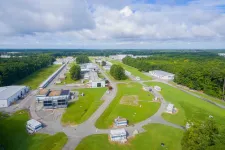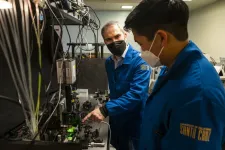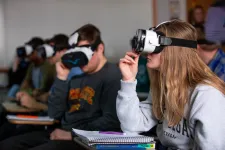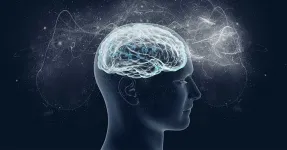(Press-News.org) Electroencephalography (EEG) is an indispensable tool used by clinicians to diagnose neurological diseases and by researchers to study and discover brain circuit mechanisms that support sensory, mnemonic, and cognitive processing. A new software - Openseize - created by Dr. Matthew Caudill, an investigator at the Jan and Dan Duncan Neurological Research Institute at Texas Children’s Hospital and assistant professor at Baylor College of Medicine, can now analyze massive amounts of one-dimensional digital signals including huge EEG datasets. The study was published in the Journal for Open Source Software.
“Typically, EEG signals are recorded using devices that have a channel count between 1-10 electrodes,” Dr. Caudill said. “However, recent advances in thin-film electronics have resulted in new types of recording devices that can simultaneously record from thousands of channels, each of which records the activity of many neurons from a particular brain region for long periods of time (e.g. months). Currently, these new high-throughput EEG recording devices are being used to record very high-quality neural activity from the brains of rodent models. This has led to the incredible challenge of how to process such massive amounts of data in an efficient and reliable manner.”
Mechanistically, EEGs are moving time series that capture alterations in the brain’s electromagnetic field arising from synchronous synaptic potential changes across neuronal populations. Linear digital signal processing (DSP) tools are routinely used in EEGs to reduce noise, resample the data, remove artifacts, expose the data’s spatiotemporal frequency content, and much more.
“We typically run this data through mathematical analyses to mine and extract useful biological information from such datasets,” Dr. Caudill said. “The problem is even the most high-end computers do not have large enough memory to perform computations on the massive datasets that are being generated by the new recording devices. To tackle this issue, I designed Openseize software to break down large datasets into smaller fragments that are amenable to typical computations and then assemble these analyzed chunks to build up to the full solution. It is analogous to how we bake a complex multi-tier cake – first, we gather the ingredients needed to bake individual components from the pantry, bake each tier one–by-one and finally, assemble the cake.”
In a similar fashion, Openseize first provides instructions for extracting the right-sized chunk of data from the file on disk (‘data producer’) that can be easily stored in any average computer’s memory. Using this data producer, users can then customize processing pipelines that will operate on each chunk of the data to extract important biomarkers such as frequency densities, spike rates, and much more. Once complete, this sequence of steps is repeated for other snippets until the entire dataset is analyzed. The analyzed segments are then assembled into the final product.
“Currently, this software is being used at the Duncan NRI to detect and study several biological events from EEG and electromyography (EMG) data in animals including seizure events, understanding brain activity patterns, and long-term motor coordination in different models of neurological diseases,” Caudill added. “This open-source software has much wider applicability beyond analyzing electrical signals in the brain and muscles. In theory, it can be used to analyze any one-dimensional digital signals such as audio signals, which means there are many more ways one could explore using this software to analyze biomedical and other data in the future.”
This work was generously supported by the Ting Tsung and Wei Fong Chao Foundation.
END
Openseize: A novel open-source software to analyze large-scale digital signals
2023-05-02
ELSE PRESS RELEASES FROM THIS DATE:
JSA Awards $558K for Initiatives Fund Program for FY2023
2023-05-02
WASHINGTON, DC – Jefferson Sciences Associates (JSA) has announced the award of $558,060 through its JSA Initiatives Fund Program. The program supports projects by staff and scientific users at the U.S. Department of Energy’s Thomas Jefferson National Accelerator Facility. The FY23 program awards leveraged over $800,000 in matching funds, and taken together, the program and matching awards total over $1.3 million. Project awards include scientific meeting support, education and career development, and outreach activities, ...
Deep neural network provides robust detection of disease biomarkers in real time
2023-05-02
Sophisticated systems for the detection of biomarkers — molecules such as DNA or proteins that indicate the presence of a disease — are crucial for real-time diagnostic and disease-monitoring devices.
Holger Schmidt, distinguished professor of electrical and computer engineering at UC Santa Cruz, and his group have long been focused on developing unique, highly sensitive devices called optofluidic chips to detect biomarkers.
Schmidt’s graduate student Vahid Ganjalizadeh led an effort to use machine learning to enhance ...
How the brain's dopamine circuitry helps regulate cognitive flexibility and reward-seeking
2023-05-02
The Brain & Behavior Research Foundation (BBRF) is hosting a free webinar, “How the Brain's Dopamine Circuitry Helps Regulate Cognitive Flexibility and Reward-Seeking” on Tuesday, May 9, 2023, at 2:00 pm EST. The presenter will be Nikhil Urs, Ph.D., Assistant Professor of Pharmacology and Therapeutics at the University of Florida and a recipient of a 2018 BBRF Young Investigator Grant. The webinar will be hosted by Jeffrey Borenstein, M.D., President & CEO of the Brain & Behavior Research Foundation, and host of the public television series Healthy Minds.
Register today at BBRFoundation.org
Dopamine ...
AI in medical imaging could magnify health inequities, study finds
2023-05-02
Artificial intelligence (AI) technology in the medical field has the possibility to automate diagnoses, decrease physician workload, and even to bring specialized healthcare to people in rural areas or developing countries. However, with possibility comes potential pitfalls.
Analyzing crowd-sourced sets of data used to create AI algorithms from medical images, University of Maryland School of Medicine (UMSOM) researchers found that most did not include patient demographics. In the study published April 3 in Nature Medicine, the researchers also found that the algorithms did not evaluate for inherent biases either. That means they have ...
Cybersickness more likely to affect women, ongoing research to understand why
2023-05-02
AMES, IA — Iowa State researchers in psychology and engineering found women experience cybersickness with virtual reality headsets more often than men. Their ongoing work, supported by a new $600,000 grant from the National Science Foundation, explores why this difference exists and options to help individuals adapt.
Psychology professor Jonathan Kelly studies human computer interaction, spatial cognition and virtual reality. He says gender discrepancies in cybersickness may not seem that important when it’s related to video games and other forms of entertainment.
"But it’s still a problem, and when VR gets to the point ...
A method to access genetic information in blood samples and find correlations with mental health problems
2023-05-02
Using blood samples to study diseases that originate in the brain is a difficulty faced by psychiatric genetics in the search for markers of mental health disorders. Researchers at the Federal University of São Paulo (UNIFESP) in Brazil have shown that this hindrance can be surmounted by analyzing microRNAs in extracellular vesicles (EVs), which are produced by most cells in the body, including neurons and other nervous system cells.
The study was supported by FAPESP and is reported ...
Air pollution may increase risk of dementia, complicated by genetics
2023-05-02
Three years ago, an international study commissioned by the journal Lancet listed 12 modifiable factors that increased the risk of dementia, including three new ones: excessive alcohol, head injury and air pollution.
Writing in the May 2, 2023 issue of the Journal of Alzheimer’s Disease, a team of researchers, led by scientists at University of California San Diego, further elaborate on how exposure to the last of those new factors — ambient air pollution, such as car exhaust and power plant emissions — is associated with a measurably greater risk of developing dementia over time.
Senior author William S. Kremen, PhD, professor ...
New RNA-seq, metabolomics protocol offers more efficient extraction that maintains data integrity
2023-05-02
GRAND RAPIDS, Mich. (May 2, 2023) — Van Andel Institute scientists have developed a new extraction protocol for RNA-seq and metabolomic analysis, offering a more complete picture of cellular activity than either technique on its own.
The protocol employs a streamlined extraction from a single sample, which reduces variation, improves efficiency, preserves data fidelity and maximizes use of precious biospecimens.
“Our new technique enables researchers to study metabolic phenotypes in a unique way while getting the most information we can out of single samples,” ...
UMass Chan scientists deliver siRNA therapy to lung
2023-05-02
Scientists at UMass Chan Medical School have developed a technology to deliver gene therapy directly to lung tissue through intranasal administration, a development that could potentially create a new class of treatments for lung disease.
Published in The Proceedings of the National Academy of Sciences, the study by a multidisciplinary team of RNA biologists, chemical biologists, immunologists and virologists describes the delivery of siRNA molecules locally to lung tissue. It is the first demonstration that multimeric ...
Forced water-use cuts made California more waterwise
2023-05-02
After a drought-stricken California lifted a year of mandatory water-use cuts that were effective in 2015 and 2016, urban water use crept back up somewhat, but the overall lasting effect was a more waterwise Golden State, a University of California, Riverside, study has found.
Published Tuesday, April 25, in the journal Water Resources Research, the UCR study found that water use by 2019 was still lower than it was in 2013, thanks in large part to water use changes by larger water users.
The water-reduction mandate imposed ...






